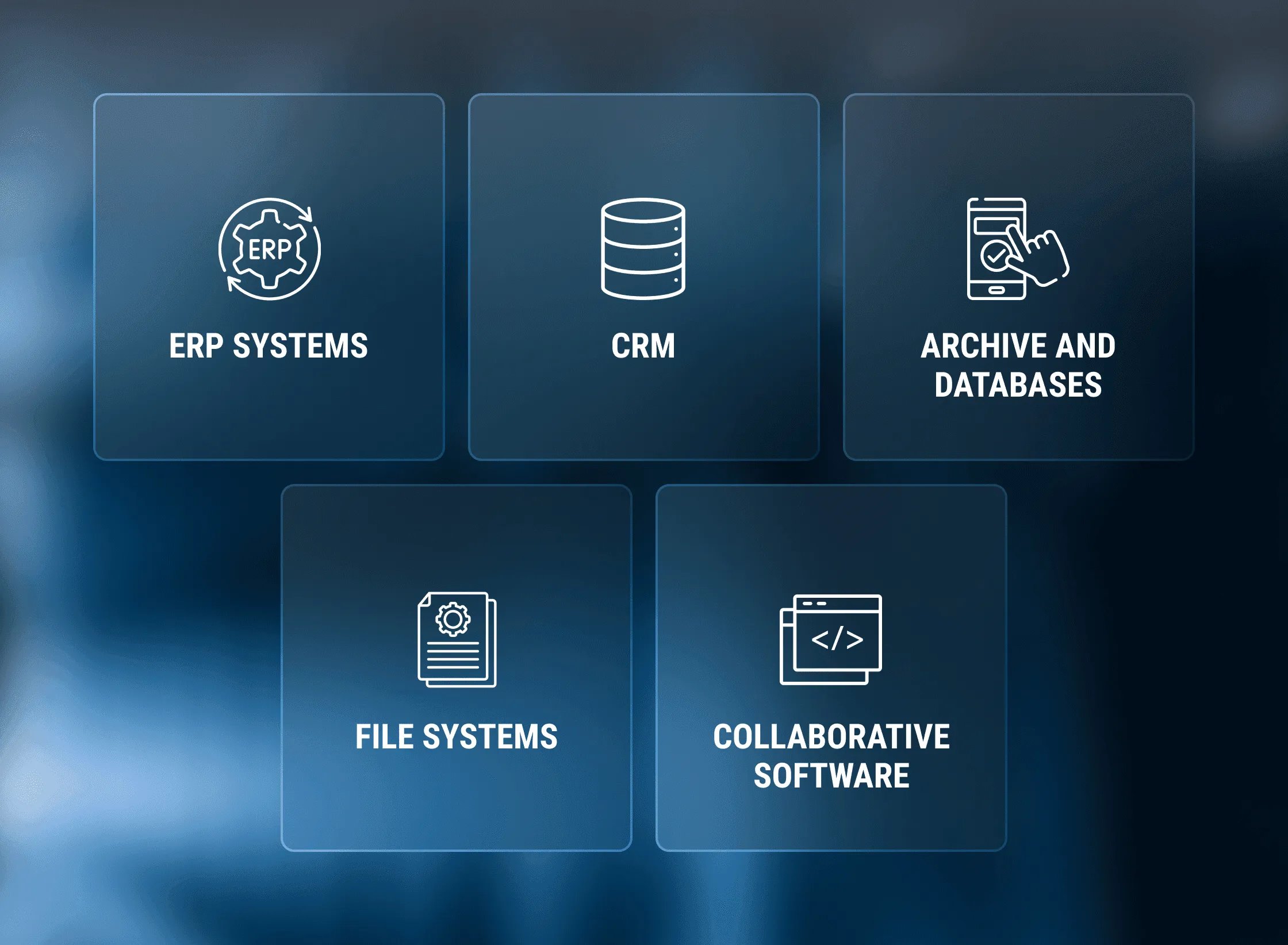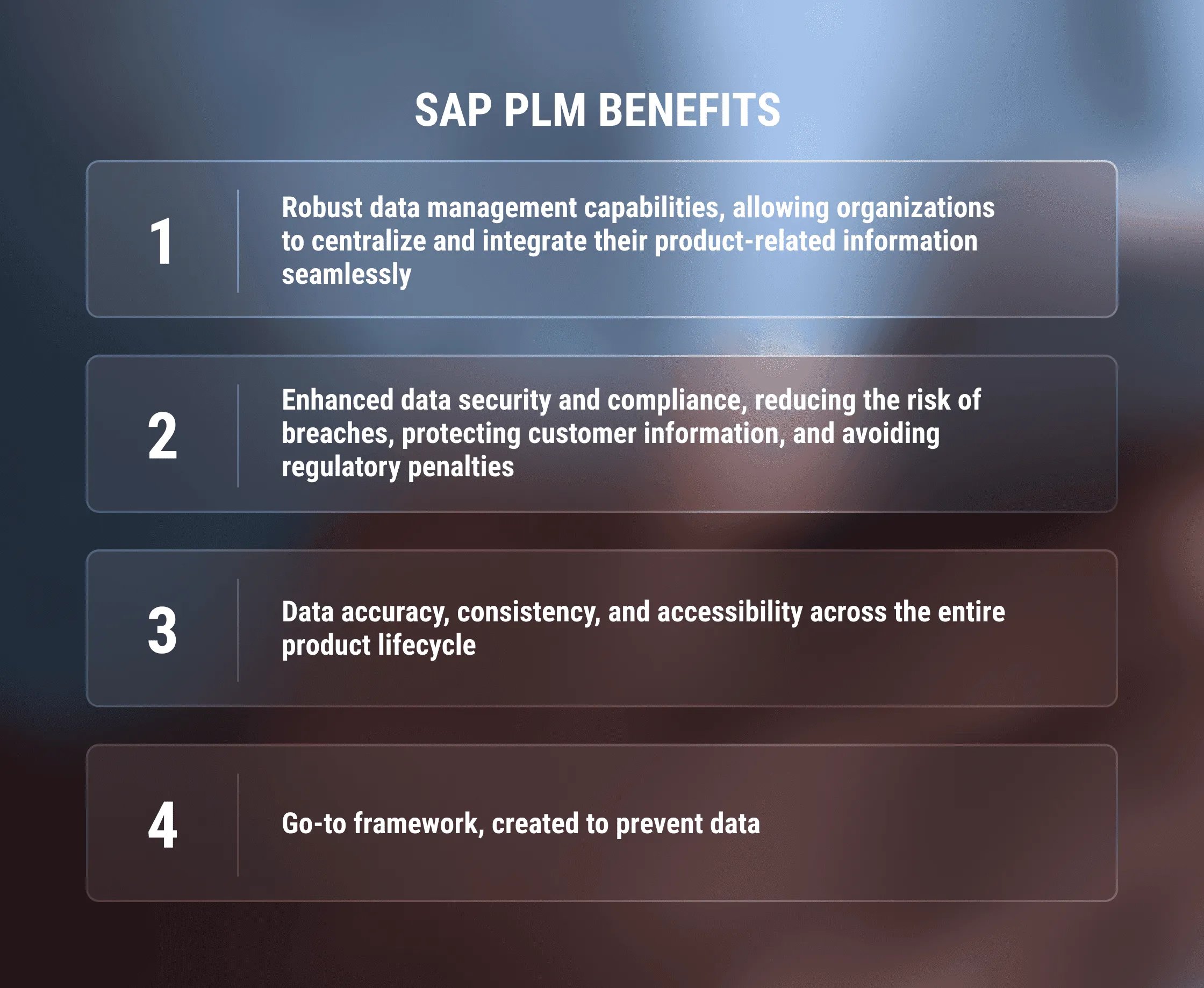Many companies pride themselves on ensuring robust data management. But some silent killers may disrupt routine processes, which are data silos. How to identify and eliminate them? Gather answers and insights from the article co-authored with SAP and LeverX experts.
How Data Silos Slowly Disrupt Your Business and How to Avoid It
Many departments and teams manually enter a great deal of information. Additionally, they use multiple tools to automatically generate data for work organization, marketing measures, customer relationship management in sales, enterprise resource planning, and much more.
This article presents a collaboration of experts from SAP and LeverX — Ismail Serin, Head of Product Management, SAP PLM, and Eric Stajda, VP of Services and Product Development, LeverX — to share knowledge from several perspectives and experiences. Let’s dive into the data silos nature and learn how to organize information.
What Is a Data Silo?
Eric: A data silo refers to data owned by a specific group that is not easily accessible by other departments within the organization. Because teams like finance, administration, HR, and marketing require distinct information for their respective tasks, they tend to store their data in separate locations, resulting in data silos. This parallel can be drawn from storage facilities used by farmers for various grains. As the number and diversity of databases increase, so do the data silos, further complicating data accessibility and integration.
It's crucial to remember that data in silos is not healthy. Data is healthy when it is accessible and easily traceable across the organization. If users cannot find the needed data in a timely fashion, or if one considers it untrustworthy after seeing it, it doesn’t add any value to analysis and decision-making processes.
Ismail: This data isolation can create a situation where the data isn't easily accessible or usable by other parts of the organization that might benefit from this information. In essence, a data silo restricts the flow of information, leading to inefficiencies and reduced insights due to a lack of a holistic data view.
What Are Some Examples of Data Silos?
Ismail: Relating this to PLM, consider the different stages a product goes through, from its initial conceptualization and design, through production and distribution, to its use, maintenance, and eventual retirement. Each of these stages generates and requires different sets of data. For example, the design phase may create and use data related to product requirements, while the distribution phase may focus on logistics and inventory data.
In an ideal scenario, data generated at each product lifecycle stage should be readily available and easily accessible for all other stages. This allows for better decision-making and more efficient operation. However, this isn't the case when data silos exist in an organization.
For example, imagine if the data generated during the production phase is kept within a silo, inaccessible to those working in the maintenance stage. This could lead to scenarios where maintenance teams cannot predict potential product faults because they don’t have access to production data, such as machine calibration parameters or batch-specific variations, which could contain essential information for understanding product performance.
This lack of integrated data access might hinder predictive maintenance strategies' effectiveness and could lead to product failures, customer dissatisfaction, and increased costs.

How Is a Data Silo Created?
Eric: Operations, HR, admissions, and other departments tend to work in their own worlds. Each has its own vocabulary, processes, and challenges. They work in physically separate areas, so each department naturally considers itself separate from the others — such a culture of separation also ties to data. Since company-wide data sharing only recently became a company goal, departments haven’t been motivated to share.
Therefore, data silos arise naturally over time and reflect organizational structures. Each department collects and stores its data to create its own data silo.
At first glance, data silos may seem harmless, but such isolated data makes information sharing and collaboration between departments difficult. Data quality also suffers due to data inconsistencies across silos. Finally, data silos make it difficult for executives to gain a holistic view of enterprise data.
Ismail: Data silos can occur or be created within a company for several reasons. Here are some key factors:
-
Organizational Structure: In large companies, different departments or teams often operate independently, each with its own goals, responsibilities, and data requirements. Over time, these teams may develop their own data management systems to cater to their unique needs, forming silos.
-
Technological Differences: Different teams within a company might use different tools that are incompatible with one another. This can lead to the creation of silos, as data from one tool may not be easily transferred or accessible to another.
-
Lack of Standardized Processes: Without standard protocols and procedures for data management across the entire company, individual teams or departments may create their own, resulting in data silos.
How Can Сompanies Identify Data Silos in Their Business Process?
Eric: A few factors listed below may indicate a potential data silo problem in the company.
Inconsistent data reporting
Disparate departments report inconsistent data, which may indicate isolated data storage systems and a lack of standardized processes for data management.
Limited data accessibility
Teams encounter difficulties finding or accessing relevant data, highlighting potential data silos that impede efficient collaboration and decision-making.
Executives' data complaints
Executives express frustration over the lack of comprehensive data on certain business operations, suggesting the existence of data silos that hinder a holistic view of the organization.
Incomplete or outdated data sets
End users constantly face incomplete or out-of-date data sets, pointing to potential data silos that result in fragmented and unreliable information across different systems or departments.
Unforeseen IT costs
Unexpected, out-of-budget IT costs arise abruptly, often indicating the need to integrate and consolidate data systems to eliminate inefficiencies caused by data silos.
Ismail: Additionally, here are some ways companies can identify data silos in their business processes:
Delayed decision-making
If decision-making processes are frequently delayed because teams are waiting on information from another department, it could be a sign that data silos exist. This indicates that data isn't readily accessible across the organization.
Duplication of effort
Data silos often lead to duplicated efforts, as different teams may independently collect, clean, or process the same data without realizing it. If a company notices repeated or redundant work, it could indicate the presence of data silos.
Lack of cross-functional insights
If teams find it difficult to obtain a holistic view of business operations or customer experience, it's likely due to data silos. For example, if the marketing team can't easily access customer usage data from the product team to refine their campaigns, a data silo could be the issue.

Why Is It Important to Overcome Data Silos?
Eric: Overcoming data silos is crucial for a company's sustainability. Integrated data enables the company to understand its operations, customers, and market dynamics comprehensively. This knowledge is essential for making informed decisions, identifying growth opportunities, and mitigating risks effectively. Below are three key reasons why overcoming data silos is important.
1. Time is money
When the same information is stored in different places, and users download the data in their personal or group storages, resources suffer. According to McKinsey, employees spend almost one-fifth of their average week searching and gathering information. This means every employee spends 8-10 hours per week gathering the required information.
In an organization of 100 people, assuming you pay an average of $10 an hour to your employees, the information collection would cost you around $416,000 annually (52 weeks x 8 hrs x $10/hr x 100 employees).
2. Lack of a сollaborative environment
When each department uses its own data sets to make decisions, implement policies and create its own myopic vision based, it can negatively and significantly impact departments and the organization as a whole. If your departments are not working towards achieving a common goal, you will not achieve your company’s goals and vision. The creation of data silos not only restricts the transparency in the organization but also creates extreme competitiveness between the departments which were otherwise supposed to be working cohesively.
3. Failure to see the big picture
Data silos give you an incomplete view of your business operations. They prevent you from getting a 360-degree view of your business by limiting information and removing data authenticity. They slow down your business growth and hamper you from achieving your true goal.
What Are Some Ways to Avoid Silos?
Ismail: The most important “tool” to avoid data silos is the definition of clear business processes across departments, including roles & responsibilities. When everyone understands the bigger picture — how data moves through different departments and how their work impacts others — it can help break down barriers.
This clarity enables smoother data transitions, reduces bottlenecks, and ensures that no department becomes a data gatekeeper, thereby preventing the formation of data silos. This often requires cross-departmental meetings and collaborations to establish a common understanding of data processes and to identify areas where data sharing can be improved.
Additionally, using Business Process Management software can help map and monitor these processes and workflows, providing further transparency and helping to avoid data silos.
How Can Companies Solve the Scattered Data Problem?
Eric: In every company, there will always be multiple systems in which data and documents are stored. Some of these include:

Thanks to technological developments, combining data for analysis has become much faster and easier with the cloud. Cloud-based tools streamline the process of data collection in a shared pool and unified format to increase analysis efficiency. What used to take weeks, months, or years can now be done in a few days or even hours.
Ismail: Breaking down data silos and managing scattered data is a multi-faceted process. Here are some commonly practiced solutions that companies employ:
Design and implementation of cross-departmental business processes
To effectively break down data silos, companies need to go beyond technological solutions and address the organizational and process aspects as well. In this regard, creating clear, documented workflows that span different departments can be extremely beneficial. This practice ensures that every department understands how data moves within the organization and how their work impacts the whole.
Cloud-based solutions
Cloud solutions like SAP Enterprise Product Development (EPD) offer an integrated environment for data to be shared and accessed across departments and locations, helping to break down silos. Known as the “Digital Thread,“ cloud services like SAP EPD often provide built-in tools for data management and analytics and will soon include AI, too.
Data integration
This involves combining data from different sources into a single, unified view. Integration services can be used to consolidate data from disparate systems like ERP, PLM, Manufacturing, and other Supply Chain Solutions.
APIs and microservices
APIs can help different cloud services interact with each other and share data. In a microservices architecture, each service is a small, independent component that runs a unique process and can communicate with other services via APIs. This architecture helps break down data silos by making data more accessible across different parts of an organization.
Adopting ERP cloud systems
ERP like SAP S/4HANA Cloud integrates various business processes into one unified system to be shared across a company. By integrating various functions (like operations, finance, and HR), ERPs can help break down data silos.
Is SAP PLM a Solution for Data Silo Management?
Ismail: SAP EPD provides a unified platform to handle all the information related to a product throughout its lifecycle. It integrates data and processes from various product lifecycle stages and different organizational departments into one system. This integration ensures that all stakeholders have a single source of truth about a product, from its conception and design, through production and maintenance, to its retirement.
By centralizing this data, SAP EPD eliminates data silos that often form between different departments, such as design, manufacturing, service, and asset management. Everyone has access to the same data and can collaborate more effectively. For instance, designers can see production constraints and feedback, while those in marketing and sales can access detailed product specifications and status updates.
Furthermore, SAP EPD integrates seamlessly with S/4HANA Cloud enabling a free data flow across these systems — aka the Digital Thread. This broader integration can further help break down data silos across the organization.
In essence, SAP EPD helps create a collaborative environment where data is shared and accessible, which is crucial in managing and preventing data silos. However, successful implementation not only relies on the system itself but also requires the company to have the appropriate data governance, processes, and a culture of collaboration.
How Exactly Does SAP PLM Help Eliminate Data Silos?
Eric: As technology advances, organizations witness a proliferation of diverse IT systems and processes, resulting in increasingly complex and heterogeneous landscapes. This presents a significant challenge, particularly when managing product lifecycles effectively. The ability to structure product data becomes cumbersome, concealing potential weak points and areas for improvement. So, how can businesses overcome this obstacle?
To do that, companies can utilize SAP Product Lifecycle Management (SAP PLM), which offers a comprehensive approach to organizing data. SAP PLM provides businesses with a holistic PLM strategy that seamlessly integrates processes and systems, enabling effortless data management across the entire organization.

Ismail: Moreover, managing and connecting data silos with SAP EPD involves strategic planning and execution. It requires thorough planning, execution, and continuous management.
Having a dedicated team or hiring external experts to oversee the cloud implementation process is recommended. A standard implementation often employs the following steps:
1. Requirements analysis
Before starting the cloud implementation, the first step is to analyze business needs and objectives. This includes understanding the functionalities you need for the digital thread, your budget, security requirements, and integration needs with existing systems.
2. Cloud architecture design
Design the cloud architecture to suit your business operations. This involves deciding on the kind of capabilities required to break down the silos based on the requirements.
3. Migration planning
Develop a detailed plan for moving your data and applications to SAP EPD. This should include steps to ensure data integrity and minimize downtime during the transition. You might opt for a phased approach, moving one component at a time, or a 'big bang' approach, moving everything simultaneously.
3. Security and compliance check
Ensure that the SAP EPD meets all necessary security standards and regulatory compliance requirements relevant to your business. This could involve data encryption, setting up firewalls, and access controls.
4. Implementation and migration
Begin the migration of the SAP EPD. Monitor the process closely to identify and quickly resolve any issues that arise.
5. Testing
After migration, thoroughly test the new system for performance, security, and functionality. Ensure all components work as expected and the system meets the operational requirements.
6. Training
Provide necessary training to your employees to effectively use the new cloud solution. This may involve workshops, tutorials, and hands-on training sessions.
7. Monitor and optimize
After the implementation, continuously monitor the cloud environment to ensure it's working optimally. Regularly review and analyze the performance metrics to identify any areas for improvement.
TOP SAP Company
Healthcare data includes multiple patient records, regulatory compliance information, and product specifications. Therefore, it requires stringent security measures and specialized handling protocols. PLM became a single source of truth.
The result?
- 60% time reduction for cycle creation
- 25% more capacity
- Decision control process automation
- IPS-controlled workflows
- One source for specification data
TOP Systems Integration Company in 2023
LeverX’s experts blended solid technical knowledge with industry-specific experience. The phase-by-phase approach to product development allowed for the customer’s drastic business process transformation.
The result?
- 35% decrease in customer request turnaround time
- 71% decrease in average months for equipment set up in SAP to first sale (8.3 to 2.4)
- 8% decrease in requests for rework in engineering
- Automated electronic purchase requisitions
- 14 redundant data silos eliminated
Conclusion
Eric: Data silos have long been the bane of effective decision-making, collaboration, and agility within organizations. These isolated pockets of data create barriers that hinder cross-functional visibility and prevent stakeholders from making informed decisions based on a holistic view.
However, by implementing the SAP PLM system, companies can seamlessly break down these silos and integrate data from different systems.
Ismail: Breaking down data silos through a PLM system like SAP EPD adds significant value to companies by improving efficiency, collaboration, decision-making, and overall business performance. It enables companies to deliver the right product at the right time and price.
Companies can create a more streamlined, collaborative, and data-driven environment by unifying data and processes through SAP EPD. This can drive better product development, improve time to market, and ultimately, increase profitability.
How useful was this article?
Thanks for your feedback!



